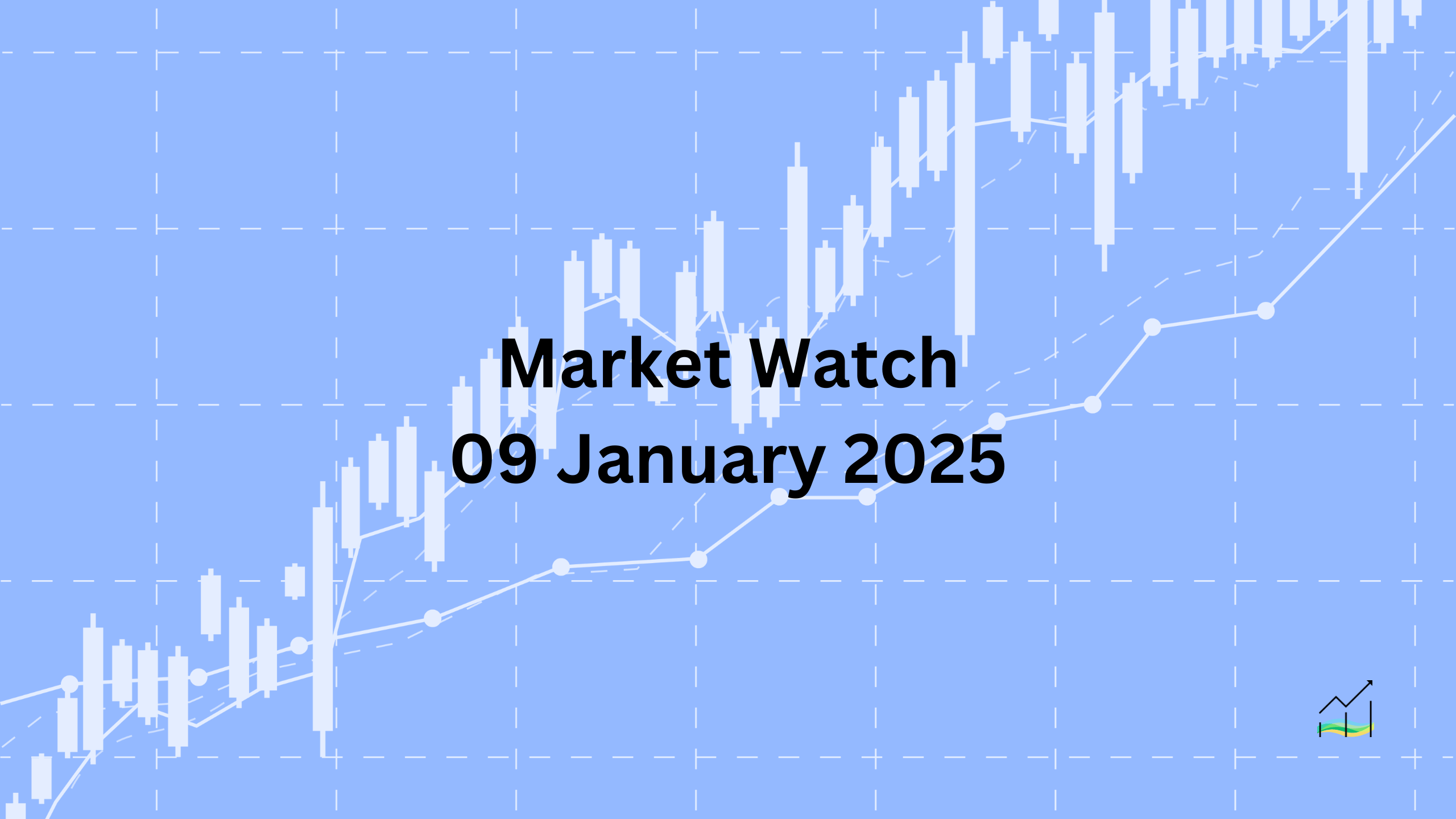09/01/2025 Market Watch

Yen Gains, Pound Pressured
The US dollar is generally stronger today, but the yen is resisting this trend, boosted by strong wage data and a softer 10-year US Treasury yield, rising nearly 0.2%. In contrast, the British pound is under pressure, hitting a new low for the year near $1.2240, weighed down by fiscal concerns and weak growth. The UK 10-year yield has increased to about 4.85%, up nearly 25 basis points this week.
In Europe, the Stoxx 600 is recovering most of yesterday’s slight decline. However, US index futures are down, with the cash market closed until after the upcoming US employment data. European 10-year yields are slightly higher, generally rising 1-3 basis points, while the US 10-year Treasury yield has dipped below 4.70%.
Gold remains firm, trading just below its recent high of $2670 and appears ready to challenge $2700 soon. Oil prices, represented by February WTI, reversed after hitting a three-month high, settling around $72.85 today after briefly reaching $75.30.
United States of America
The US stock market is closed today, with the bond market closing early in observance of President Carter's funeral. Despite the recent ADP jobs report indicating a second consecutive slowdown, the Dollar Index held firm, settling near 109.00. This level aligns with the 61.8% retracement of the decline from the September 2022 high of around 114.80 to the July 2023 low of approximately 99.60.
Looking ahead, the next psychological milestone for the Dollar Index is 110.00, with potential to test 111.00. This scenario could unfold if upcoming employment data and CPI reports prompt the market to anticipate earlier rate cuts by the Federal Reserve. Currently, the first rate cut is not fully priced in until July, reflecting a less dovish stance than the Fed's December projections, which suggested two rate cuts.
Key Points:
- Dollar Index steady at 109.00, reflecting significant retracement.
- Market eyes potential rise to 110.00 and 111.00.
- Upcoming employment and CPI reports crucial for Fed rate cut expectations.
- Current market outlook less dovish compared to Fed's December projections.
Australia & New Zealand
Since the US election, the Australian and New Zealand dollars have been the weakest among the G10 currencies, with the Australian dollar losing about 6.7% and the New Zealand dollar about 6.9%. The Australian dollar fell below $0.6200 yesterday but managed to stay above the 2024 low of just under $0.6180. Today, it neared the 2022 low of just below $0.6170, with nearby resistance at $0.6220.
Earlier today, Australia reported a 0.8% increase in November retail sales, which, while slightly below expectations, marked the largest rise since November 2023. Additionally, Australia recorded a larger-than-expected goods trade surplus of A$7.08 billion in November, compared to A$5.7 billion in October. November exports rose 4.8%, building on a 3.5% increase in October, indicating strong foreign demand over the past two months—the strongest since August-September 2022. However, for the first 11 months of 2024, Australia’s goods surplus was around A$66.2 billion, down from nearly A$112 billion in the same period in 2023.
Key Points:
- Australian and New Zealand dollars have been the worst G10 performers since the US election.
- Australian dollar neared its 2022 low today, with resistance around $0.6220.
- November retail sales in Australia rose by 0.8%, the largest increase in a year.
- Goods trade surplus in November was A$7.08 billion, exceeding expectations.
- Australia’s goods surplus for Jan-Nov 2024 was A$66.2 billion, compared to nearly A$112 billion in the same period in 2023.
Canada
The US dollar continued its recovery from Monday’s low of around CAD1.4280, reaching CAD1.4410 yesterday. Today, it is trading within a range of CAD1.4365 to CAD1.4405, near the upper end of yesterday’s levels. A retest of the 2024 high, just above CAD1.4465 set on December 19, appears likely, with the precise timing potentially influenced by tomorrow’s jobs data. Beyond this, the next target could be CAD1.45, with little resistance up to the pandemic high of around CAD1.4670 from March 2020.
Despite these movements, the Canadian dollar has been the best-performing G10 currency since the US election, depreciating by slightly less than 4%.
Key Points:
- US dollar continued its recovery, trading near the upper range of CAD1.4365-CAD1.4405 today.
- Likely to retest the 2024 high of just above CAD1.4465.
- Next targets could be CAD1.45 and CAD1.4670 (pandemic high).
- Canadian dollar has been the strongest G10 currency since the US election, with a depreciation of under 4%.
China
The dollar remains within the range set against the offshore yuan on December 31 (~CNH7.3055-CNH7.3700), but it continues to rise against the onshore yuan, reaching its highest level since September 2023. Yesterday, it broke through CNY7.33, moving slightly higher today and approaching the upper limit of the PBOC’s 2% band, around CNY7.3325.
China's December CPI showed a 0.1% year-over-year increase, suggesting mild deflationary pressures. However, this is somewhat misleading. Food prices declined by 0.5%, not due to a demand issue, while non-food prices rose by 0.2%. Core inflation, excluding food and energy, increased to 0.4%, the highest since July. Meanwhile, China's PPI ended 2024 at -2.3%, after falling by 2.7% in 2023 and 0.7% in 2022. Despite these low numbers, China’s 10-year yield remains around 1.60%, still providing a positive real rate, unlike Japan, Switzerland, and Germany, where real rates are negative after adjusting for recent CPI figures.
Key Points:
- Dollar continues to rise against the onshore yuan, nearing the upper PBOC band.
- China’s December CPI rose by 0.1%, with core inflation at 0.4%.
- PPI remains negative, ending 2024 at -2.3%.
- China's 10-year yield is around 1.60%, maintaining a positive real rate.
- Real rates in Japan, Switzerland, and Germany are negative after CPI adjustments.
Europe
The euro dipped slightly below $1.0275 yesterday following some option-related selling after breaking through $1.03. The weaker-than-expected US ADP private sector job estimate provided some support, allowing the euro to settle near $1.0320. Currently, it is trading within a tight range of $1.0285 to $1.0320. While options worth nearly 3 billion euros are set to expire today at $1.02, reaching that level appears unlikely. The $1.02 mark, approached on January 2, represents the 61.8% retracement of the euro's rise from its September 2022 low near $0.9535.
In Germany, after a significant 5.4% drop in November factory orders, industrial output saw a larger-than-expected increase of 1.5%, following a revised 0.4% decline in October. Despite this, it may not be enough to prevent a second consecutive annual GDP decline, with the first official estimate due next week. The Bundesbank projects a modest 0.2% growth for this year. On a brighter note, Germany’s trade surplus for November rose to 19.7 billion euros, up from 13.4 billion in October, driven by a 2.1% increase in exports and a 3.3% reduction in imports, leading to a 12% higher trade surplus compared to the same period in 2023.
Key Points:
- Euro dipped below $1.0275 but stabilized near $1.0320.
- $1.02 remains a key technical level but seems unlikely to be reached soon.
- Germany’s industrial output rose by 1.5% in November after a decline in October.
- Germany's trade surplus in November reached 19.7 billion euros, aided by higher exports and lower imports.
- Annual GDP for Germany may see a second consecutive decline despite recent industrial gains.
Japan
The US 10-year yield climbed to nearly 4.73% yesterday, boosting the dollar to a marginal new six-month high around JPY158.55. While the dollar remains just below this level today, it has gained in 23 of the past 28 sessions since the last US jobs report on December 6. Despite this strength, the risk of intervention by the Bank of Japan (BOJ) appears low. However, the yen's ongoing weakness has fueled speculation about a potential BOJ rate hike later this month, with the swaps market pricing in about 11 basis points, even after the latest wage data.
Japan's November labor cash earnings increased by 3.0%, exceeding expectations and following a 2.2% year-over-year rise in October. Adjusted for inflation, real earnings have been negative on a year-over-year basis since April 2022, except for June and July of the previous year. In November, real earnings fell 0.3% year-over-year, which was less than forecasted. Household spending, which had declined 1.3% year-over-year in October, is due tomorrow. The BOJ's branch managers' report acknowledged wage gains and upgraded the economic assessment for two out of nine regions. The BOJ remains noncommittal about a potential rate hike, keeping the market in suspense.
Key Points:
- US 10-year yield reached nearly 4.73%, pushing the dollar to JPY158.55.
- BOJ intervention risk is low despite yen weakness and speculation of a rate hike.
- November labor cash earnings in Japan rose 3.0%, higher than expected.
- Real earnings have been negative year-over-year since April 2022, except for June and July.
- BOJ upgraded economic assessments for two regions but remains noncommittal about rate hikes.
United Kingdom
A sell-off in UK Gilts triggered a sharp decline in sterling, pushing it below the eight-month low of $1.2355 set on January 2, finding support near $1.2320. Today, the pressure continued with sterling dropping to $1.2240 before recovering to around $1.2285 in European trading. The initial resistance is now seen at $1.23. The 10-year Gilt yield increased by another four basis points today, climbing from 4.57% at the end of last week to about 4.85%, after peaking at 4.92% earlier. This year, there have been three sessions where sterling fell by 1% or more, and it narrowly avoided a second instance before yesterday's partial recovery.
Market participants believe that sterling’s weakness might influence the Bank of England’s policy decisions. Earlier this week, the swaps market had priced in 61 basis points of rate cuts for the year, but this has now adjusted to 48 basis points.
Key Points:
- Sterling fell below the eight-month low of $1.2355 to $1.2320, recovering to $1.2285.
- Initial resistance for sterling is at $1.23.
- 10-year Gilt yield rose to 4.85%, reaching a peak of 4.92% today.
- Sterling narrowly avoided a second 1% drop for the year.
- Market expectations for Bank of England rate cuts have adjusted from 61 to 48 basis points.
© 2025 SKONE Enterprise (003319453-V). All rights reserved.
The content on this site is for informational purposes only and does not constitute financial advice.


